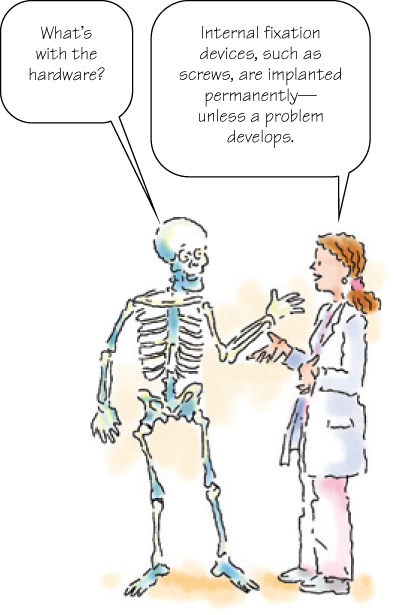In internal fixation (also called surgical reduction or open reduction), the physician implants fixation devices—using no external framework—to stabilize the fracture. Internal fixation devices include nails, screws, pins, wires, and rods, all of which may be used in combination with metal plates.
Internal fixation is typically used to treat fractures of the face and jaw, spine, and arm or leg bones as well as fractures involving a joint (most commonly the hip). Internal fixation permits earlier mobilization than other treatment options and can shorten hospitalization—particularly in elderly patients with hip fractures.

Internal fixation devices stay in the body indefinitely unless the patient has adverse reactions after healing is complete. (See Reviewing internal fixation devices.)
Ice bag  pain medication (analgesic or narcotic)
pain medication (analgesic or narcotic)  incentive spirometer or intermittent positive-pressure breathing (IPPB) device
incentive spirometer or intermittent positive-pressure breathing (IPPB) device  sequential compression device for unaffected leg(s).
sequential compression device for unaffected leg(s).
Patients with leg fractures may also need the following: overhead frame with trapeze  pressure-relief mattress
pressure-relief mattress  crutches or walker
crutches or walker  pillow (hip fractures may require abductor pillows).
pillow (hip fractures may require abductor pillows).
Explain the procedure to the patient to allay his fears. Encourage the patient to ask the physician any questions that he may have.
Checkout line
After the procedure, monitor the patient's vital signs according to your facility's protocol. Changes in vital signs may indicate hemorrhage or infection.
Monitor fluid intake and output every 4 to 8 hours.
Perform neurovascular checks following your facility's protocol. Assess color, motion, sensation, digital movement, edema, capillary refill, and pulses of the affected area. Compare findings with the unaffected side.
Comfort care
Apply an ice bag to the operative site as ordered to reduce swelling, relieve pain, and lessen bleeding.
Administer analgesics, as ordered, before exercising or mobilizing the affected area to promote comfort.
Monitor the patient for pain unrelieved by analgesics and for burning, tingling, or numbness, which may indicate infection or impaired circulation.
Elevate the affected limb on a pillow, if appropriate, to minimize edema.
Check surgical dressings for excessive drainage or bleeding. Check the incision site for signs and symptoms of infection, such as erythema, drainage, edema, and unusual pain.
Time to stretch
Assist and encourage the patient to perform ROM and other muscle-strengthening exercises as ordered to promote circulation, improve muscle tone, and maintain joint function.
Teach the patient to perform progressive ambulation and mobilization using an overhead frame with trapeze, or crutches or a walker, as appropriate.
To avoid complications of immobility after surgery, have the patient use an incentive spirometer. Apply sequential compression devices to both legs as appropriate. The patient also may require a pressure-relief mattress. (See Recovering from internal fixation and Documenting internal fixation.)
Outline
